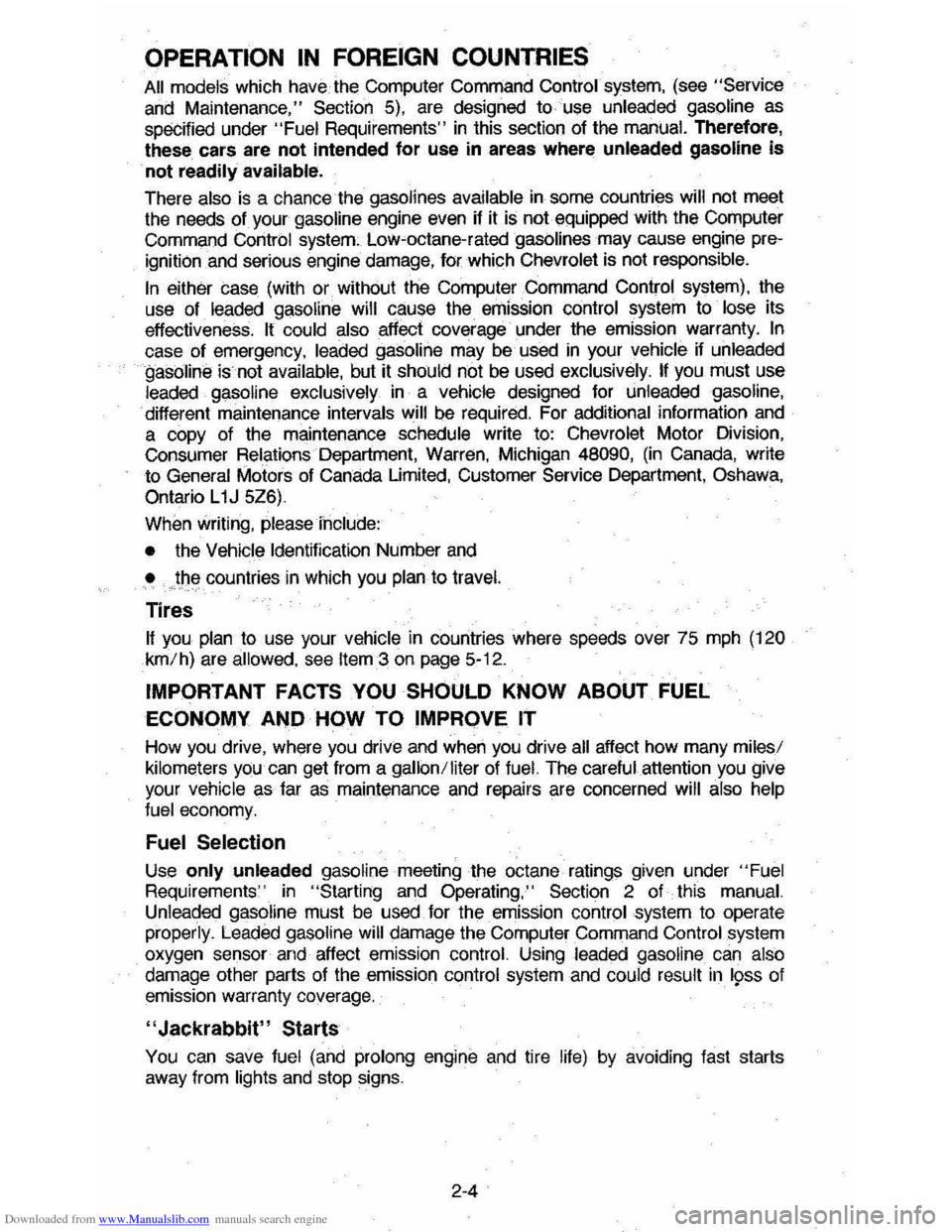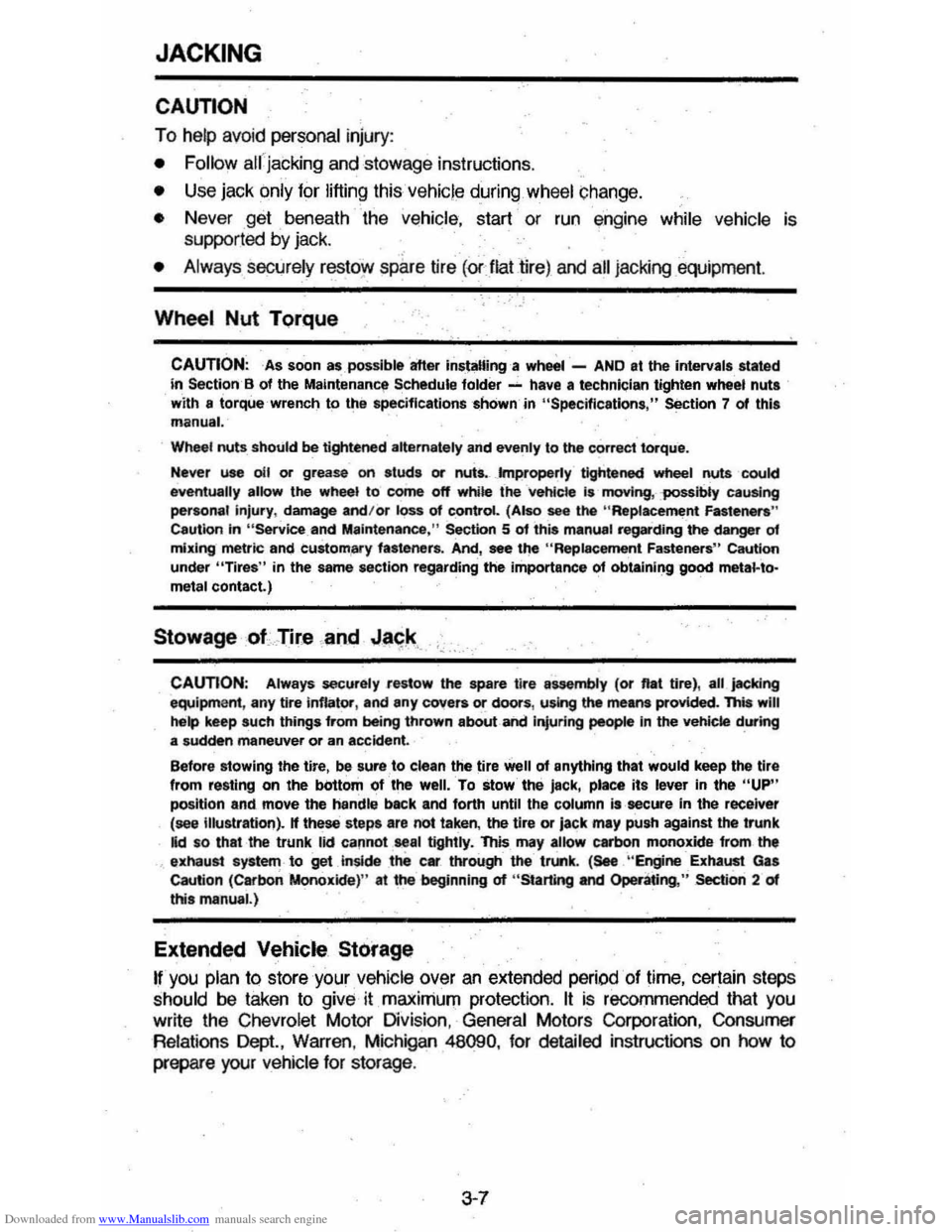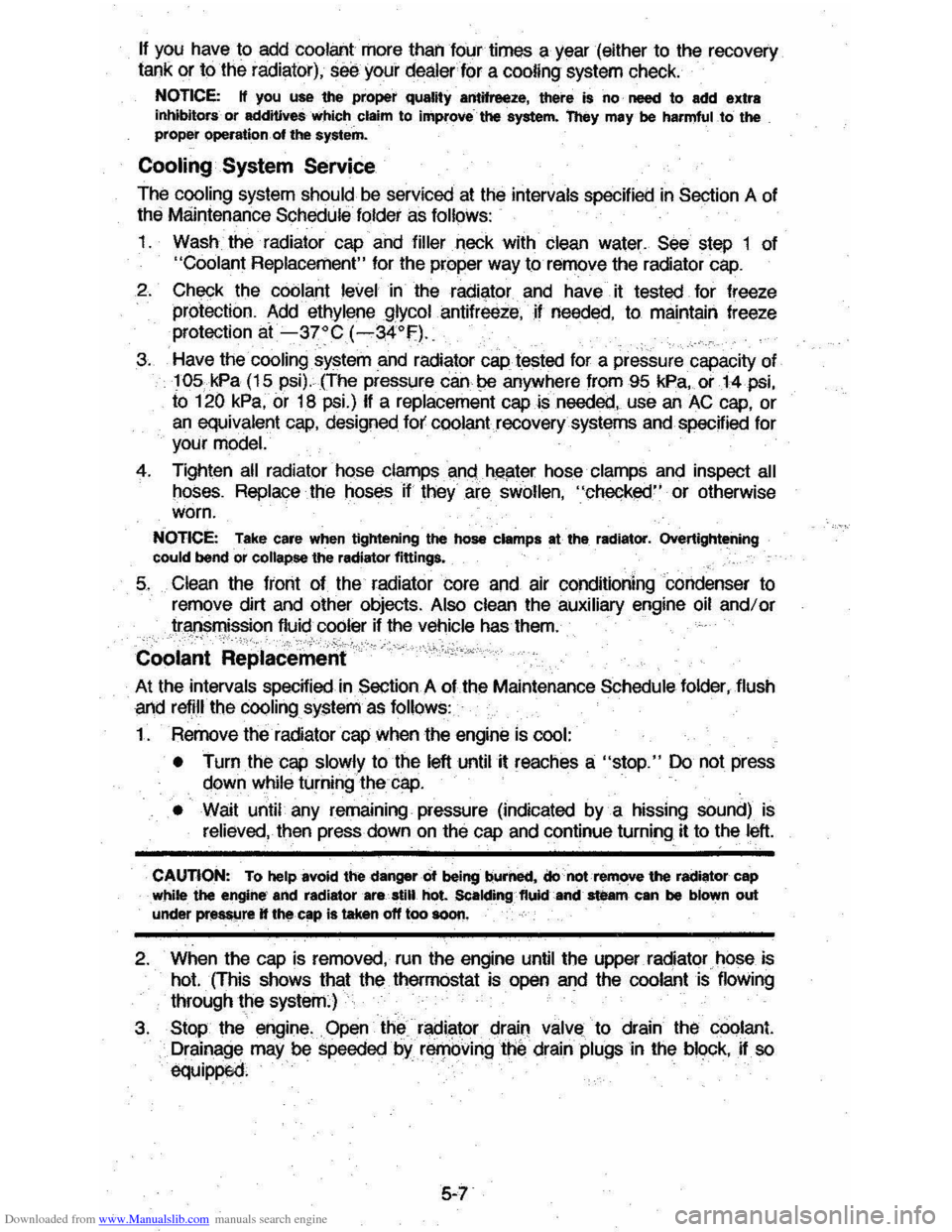service interval CHEVROLET MONTE CARLO 1981 4.G Owners Manual
[x] Cancel search | Manufacturer: CHEVROLET, Model Year: 1981, Model line: MONTE CARLO, Model: CHEVROLET MONTE CARLO 1981 4.GPages: 104, PDF Size: 23.92 MB
Page 23 of 104

Downloaded from www.Manualslib.com manuals search engine OPERATION IN FOREIGN COUNTRIES
All models which have the Computer Command Control system, (see "Service
and Maintenance," Section 5), are designed
to use unleaded gasoline as
specified under
"Fuel Requirements" in this section of the manual. Therefore,
these cars are not intended for use in areas where unleaded gasoline is
not readily available,
There also is a chance the gasolines available in some countries will not meet the needs of your gasoline engine even if it is not equipped with the Computer
Command Control system; Low~octane-ratedgasolines may cause engine pre
ignition and serious engine damage, for which Chevrolet is not responsible.
In either case (with or without the Computer Command Control system), the
use of leaded gasoline will cause the emission control system to lose its
effectiveness.
It could also affect coverage· under the emission warranty. In
case of emergency, leaded gasoline may be used in your vehicle if unleaded gasoline is not available, but it should not be used exclusively. If you must use
leaded gasoline exclusively
in a vehicle designed for unleaded gasoline,
different maintenance intervals will be required. For additional information and
a copy of the maintenance schedule write to: Chevrolet Motor Division, Consumer Relations Department, Warren, Michigan 48090, (in Canada, write
to General Motors of Canada Limited, Customer Service Department, Oshawa,
Ontario
L 1J 5Z6).
When writing, please
include:
•
the Vehicle Identification Number and
• the countries in which you plan to travel.
Tires
If you plan to use your vehicle in countries where speeds over 75 mph (120
km/h) are allowed, see lIem3 on page 5-12.
IMPORTANT FACTS YOU SHOULD KNOW ABOUT FUEL
ECONOMY AND HOW
TO IMPROVE IT
How you drive, where you drive and when you drive all affect how many miles/
kilometers you can get from a galion/liter of fuel. The careful attention you give
your vehicle as far as maintenance and repairs are concerned
will also help
fuel economy.
Fuel Selection
Use only unleaded gasoline meeting the octane ratings given under "Fuel Requirements" in "Starting and Operating," Section 2 of this manual.
Unleaded gasoline must be used. for the. emission control ,system to operate
properly. Leaded gasoline will damage the Computer Command Control system
oxygen sensor and affect emission control. Using leaded gasoline can also
damage other parts of the emission control system and
CQuld result in 19s8 of
emission warranty coverage.
"Jackrabbit" Starts
You can save fuel (and prolong engine and tire life) by avoiding fast starts
away from lights and stop signs.
2-4
Page 59 of 104

Downloaded from www.Manualslib.com manuals search engine JACKING
CAUTION
To help avoid personal injury:
• Follow air jacking and stowage instructions.
• Use jack only for lifting this vehicle during wheel change.
• Never get . beneath the vehicle, start or run engine while vehicle is supported by jack.
• Always securely restol" sp!.re tire (orflattire) and all jac king equipment.
Wheel Nut Torque .
CAUTION: As soon as possible atter installing a wheel -AND at the intervals stated
In Section 'S of the Maintenanc," Schedule folder --have a technician tighten wheel nuts with a torque wrench to the specifications shown in "Specifications," Section 7 of this manual.
Wheel nuts should be tightened alternately and evenly to the correct torque.
Never use oil or grease on studs Of nuts.. Jrnproperty tightened wheel nuts could eventually aUow the whee! to come off while the veNeta Is moving, -po$$rbty causing
personal injury , damage and/or klss of c_ontrol. (Also see the "Replacement Fasteners" Caution In "Service and Maintenance ," Section 5 01 this m8nu81 regarding the danger of mixing metric and custom,sry fasteners. And, see the "Replacement Fasteners " Caution
under "Tires" in the same seclion regarding the importance of obtaining good metal-to
metsl contact.)
Stowage ·of. Tire . and .!aC;.k,. . .
CAUTION: Always securely restow the spare tire assembfy (or nat tire), all jacking equipm ent, any tire inflator, and any covers or doors, using the means provided. This will help keep such things from being thrown about-and injuring people In the vehicta d.Ufing a sudden maneuver or an accident.
Before stowing
the tire, be sure:to clean the tire well 01 anything that would keep the tlr. from resting on the bOttom of the well. To stow the jack, place its lever in the "UP" position and. move the handle back and forth until the column is ·secure in the receiver (see Illustration). If these steps are not taken, the tire or lack may push against the trunk lid so thai the trunk lid cannot seal tightly. This _ may allOw carbon monoxide from the '. exhaust system -to get _inside tiMt c • . ttvougtl the trunk. (See "Engine -Exhaust Gas Caution (CaroonMonoxkle) " al the beginning of "Starting and Operating,'; Section 2 of this manual .)
Extended Vehicle Storage
If you plan to store your vehicle over an extended periOd of time, certain steps
should be taken to give it maximum protection.
It is recommended that you
write the Chevrolet Motor Division , General Motors Corporation, Consumer
Relations Dept., Warren , Michigan
48090, for detailed instructions on how to
prepare your vehicle for storage .
3-7
Page 72 of 104

Downloaded from www.Manualslib.com manuals search engine Choosing Oil Viscosity
Engine oil viscosity (thickness) has an effect on fuel economy. Lower viscosity engine oils can provide· better fuel economy; however, higher temperature
weather cOl1ditions. require· higher viscosity .engine. oils· for satisfactory
lubrication.
It is recommended that you select an oil not only of the proper quality and
viscosity, but also. a fuel-saving product.· These oils can be found in Chevrolet dealer serviGe departments, service stati()ns and other retail stores. They are
identified by words such as: "Energy Conserving," "Energy Saving," "Conserves Gasoline," "Gas Saving," "Gasoline Saving," "Friction
Reducing," "Improved Gasoline Mileage," "Improved Fuel Economy" or "Fuel
Saving."
The following chart lists the engine oil viscosities recommended for the
tE3lT1per~ture range you·. expecLbefore your next oil change. For temperatures
above -18'C '(O'F), SAE 10W-30 is the preferred viscosity grade. If coldweather starting problems are encountered at temperatures below -18'C
(O'F), SAE 5W-30 viscosity oils m?-y be required.
Change Intervals
The oil and oil filter change intervals for your engine are based on the use of SF-quality oils and high-quality filters such as AC oil filters. Using oils other
than
SF-quality, or oil and/or filter change intervals longer than recommended, could reduce engine life.
Damage to engines due to improper maintenance or use of incorrect oil quality
'andl0r"'vi$9()~ity}s .~ot covered by the Chevrolet new car warranties.
Your engine WEIS filled with a high-quality engine oil when it was built. You do
not have to change this oil before the first recommended change
interval.
•
Severe Service-Change the oil and oil filter every 3,000 miles (4 800
kilometers) or three months (whichevefcbmes first) if one or more of the following "severe service" conditions is often encountered:
• Driving in dusty areas.
• Towing a trailer.
• Frequent idling or idling for long periods.
• Oriving 4 miles (6 kilometers) or less in freezing weather.
• Change the oil and oil filter as soon as possible after driving in a dust storm.
~ Norma! Service-If your engine is not a turbo-charged engine and your
normal driving does not include one of the above "severe service" conditions, change the oil every 7,500 miles (12 000 kilometers) or 12
months, whichever comes first. Change the oil
filter at the first oil change,
then every other
oil change, if mileage (7,500 miles or 12 000 kilometers)
determines when you change the oil. If time (12 months) determines when
you change the oil, change the filter with every oil change.
• If you have a turbocharged engine, it is VERY IMPORTANT to change the
oil and oil filter EVERY 3,000 miles (4 800 kilometers).
5-4
Page 75 of 104

Downloaded from www.Manualslib.com manuals search engine If you have to add coolant more than four times a year (either to the recovery
tank or to the radiator), see your dealer for a cooling system check.
NOTICE: If you use the proper quality antifreeze, there is no· need to add extra inhihitorsor additiveswtlich claim to improve-the system. They may be harmful to the proper operation of the system.
Cooling' System Service
The cooling system should be serviced at the intervals specified in Section A of
the Maintenance Schedule folder as follows:
1. Wash the radiator cap and filler neck with clean water. See step 1 of "Coolant Replacement" for the proper way to remove the radiator cap.
2. Check the coolant level in the radiator and have it tested for freeze
protection.
Add ethylene glycol antifreeze, if needed, to maintain freeze
protection at-3JOC (~$4°f).
3. Have the cooling system and radiator cap tested for a pressure capacity of 105. kPa (15psi). (The pressure cantle anywhere from 95 kPa, or 14 psi,
to 120
kPa, or 18 psi.) If a replacement cap is needed, use an AC cap, or
an equivalent cap, designed fof coolant recovery systems and specffied for
your model.
4. Tighten all radiator hose clamps ang heater hose clamps and inspect all
hoses. Replace the hOSes if they are swollen, "checked" or otherwise worn.
NOTICE: Take care when tightening the hose clamps at the radiator. Overtightening could bend or collapse the radiator fittings.
5. Clean the front of the radiator core and air conditioning condenser to
remove dirt and other objects. Also clean the auxiliary engine oil andlor
transmission fluid cooler if the vehicle has them.
Coolant Replacernent
At the intervals specffied in Section A of the Maintenance Schedule folder, flush
9r1d refill the cooling system as follows:
1. Remove the radiator cap when the engine is cool:
•
Turn the cap slowly to the left until it reaches a "stop." Do not press
down while turning the
cap.
• Wait until any remaining pressure (indicated by a hissing sound) is
relieved, then press down on the cap and continue turning it to the left.
CAUTION: To help avoid the dangarm being burned. donotrem_ove the radiator cap While the engine' and radiator are. still. hot. Scaldingftukland steam ean be blown out under ~re It the cap is taken off too SOOf1.
2. When the cap is removed, run the engine until the upper rad.iator hose is
hot.
(ThiS shows that th~ thermostat is open and the coolant is flowing
through the system.)
3. Stop the engine. Open Ihe,actialor drain valVE! to drain the coolant. Drainage may be speeded by removing the drain plugs in the block, ff so
equipped.
5-7
Page 99 of 104

Downloaded from www.Manualslib.com manuals search engine ~_ fOIl a/or OdIe) ... .. 2·17 Engine -T""1* .... -(tOn... . ..... -2·17 FASTEN SEAT BELTS._ .......... -1·5 GEN (Electrical Sysl.m) . . ........ 2·17 Hazard War'rWIg Flasher . . ........ . 3·1 Headlight Circuit breaker.. . 2·~.7·3 HeedigtIf SWi1ch ••...• _ ..... ......•..•...• 2·7. 2.21
HeadIirj1ts On Reminder .. . ....... 2-21 Hi!tI·Beam rdcaIor .. . ....... 2·21 t-K>T. . ...........•.• _ .. ....... ....... 2-'17 Instrumenl Panel... ...... 2.15 Interior .... 01.. (PresstMe) .. ... .
--
....• . '2-30 2·19 ...... 2·14 Seal Bell FIerrindBf.. 1·8 Switch Headlights ................. ......... 2·21 TEMP (Teq)8falU'e). . ...... 2,19 LJmited·SIp Oift«enIiaI.. . ........ _5--5
""'" DOOr, . • ... ... ... 1,2 ._ .... . 2·16 GloVe Box .. 19ni1ion .. .... ............. ....... .......... _ .. 2--6 Keys ,.,
Theft Protection .... ..... ..... .........• ............. 2:2 Tn,ri:. -Powcw I\aIease .. ... 2·22 Low Seat. Child & ""8111.. . ... _. HI _ Luggage /Cargo Capacity. ; ..... ,. ..... 5-11 Mainlen
5-3. 7·1 ................ 2·19 . ................. 2·17 . ........ 5- ,3
Turbo Chaoge Interval .... ........... 2·33. 5-4 01.. Ught . . .......... .... 2-17 Openings. Roof ....... ... .. : ..... (See " Roofs") Opening 'The Hood (tnside Back Cover) Trunk ..... 2-22 Windows 1-2 Operating SpeecI$ . New car . __ -2-2 OperMing rIPS Fuel Economy .. : .... : ..... . __ ... 2"" Trailer Towing.. 1-12 Transmission .. . .... ...... 2-9 V...tilaeion Sys&em.. . ...... 2-22 Openllion ., Foreign Countries .. 2-4 Outside AIIarYiew Minor. _. . 1·3 Overheating" Engine 3-3 'Oversees Operation .. 2-4
............. Pwting Brake Pa1cing Lights ... PCII Valv. & Filter ...
... 2·. . 2·14 ... 1·. .... 7·2 Pat.1 Travel, Brake ............................ 2,14 Poishing ' & Waxing.. .. ....... ..... .......... 4-4 PoIUion ~ .... (see "Emission ConIrol")
""-~ ... Brakft: .. Door LockS .. Seett ...
.............. .......... 2-25 . .................. 2 ·14 ' ·2 .................. . 1-3 --.g ........................... . .., 2-11 2·22 Trunk Refease-.. WIfIdOoWs .. .... '·3 Pressur •• Oil GagII... .. ..... ..... ...... 2·19 L911... ............................ .. .... 2·17 Pr ....... e. ne Innation .. . So-I 2 P\..tse ""* .. 2·20 I!'ushing to Start.. . .... ..... ............. .... 5-2 ........ Andfreaze (Coolant). .. 5-6 CAp. Pressure ... . ................... ....... 5-8 o.ddng l..IMI' ... _....... ......... 5-6 0vemee8ing .... 3·3 Tha-mostat... .. 5·8 Aldol & Antennas... .. ...... 2-26 • 2~29 ..... wndoW Defogger ... . ................... .... 2-25
--I.irJWted.SIip ...... ....... 2-30. 5-9 MainTenance. ... 5·5 Stanc*d . .. 5-9 Tra iletlng.. 1·12 ReaMew Mirrors 1 -3 Aeco-v Tn. Coolant ... __ .-.................. 5·6 -.. Hood .: ' .. .' ... ' (Inside Back Cover) Seatbac k Latch 1-4 Trunk ... .. .... 2-22 Reminder Lights .......... ....... {See "L ights ") Replacomenl fastlilOef s. . .. 5· 1 Reptacement Maint9l1anc; e Schedule. .,' 5· t Reptacement Owner's Manua:.. (See Older Form) Replacement Parts.. . ....... ..... ... , ..•. 5-1 ReWaints ... Rests. Head . {See "Seal Sells") ..... 1-5 .. , 3 -9 Rocking Car When Stuc k ... RooIs C.rying cargo On .. SunrOQll ...... v-.nyt ...... ____ .... _ ......
'·2 . ..... 2 ·30 ______ ..... ...... 4-4 AotiMiOn. Tire .......... ........... .............. ..... 5·13 Ruslprooting.. .. ........ 4-5 Rust Protection SaMIy Belts .. .....
........ 4-5 .. {See "Seal 8eIts .. )
_ .............. , .. . .. .... '·4 1 ·10 CtIiIcI ...... .................. .. ~ .. . .............. ... ... 1,3 Heet RMltaints ............................... " 1-5 laIcl'lM ..
.... -
. . ..... .... .......... .. 1-4
c. ................................ .. • ... 0&-3 1·10 Child Reser ..... .
Page 104 of 104

Downloaded from www.Manualslib.com manuals search engine SERVICE STATION INFORMATION
Refer to "Service and Maintenance,"
Section 5 for Further Details
Fuel Cap -Localed behind the license plate.
See fuel cap removal procedl,lre on page 5-1.
Fuel Requirements -Use unleaded gasoline only. See "Fuel Requirements "
in "Starting and Operating. " Section 2 of this manual.
Hood Release - Located beneath the instrument panel to the left of the
steering column. To open, pull the handle to release the hood lock. Then push down slightly on the hood while lifting the underhood lever , and raise the hood. (See illustration).
Engine Oil Oipstiek-Located on right or left side of engine block depending on engine model. Check the engine oil level when the oil is warm, such as during a fuel stop. Keep the oil level above the "Add " line on the dipstick .
Engine Oil Recommendation (Gasoline Engine) -Use only SF-quality oils. (See "Service and Maintenance," Section 50f this manuaL) The chart on page 5·5 will serve as a guide for choosing the proper viscosity oil.
Tire Inflation. Pressures -Check at least monthly (including the spare, unless it is a stowaway spare). Keep them inflated to pressures shown on
the Tire Placard on the left door. (Keep compact spare tires inflated to 415 kPa or 60 psL)
Engine Cooling System -Check the fluid level in the "see·through " coolant recovery tank at regular intervals , such as during a fuel stop. (See "Engine Cooling System " in "Service and Maintenance, " Section 5 of this manual.
Windshield Washer -Check reservoir fluid level regularly. Use a washer fluid, such as GM Optikleen .
Battery -Your new car has a Delco FREE[X)M It battery. You will never have
to add water. The hydror:neter (test indicator) in ,the cover provides information for testing purposes only.